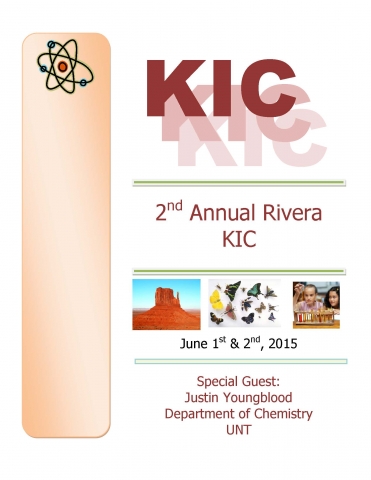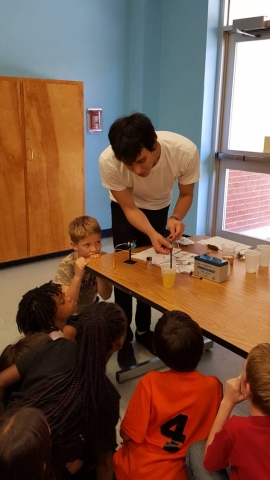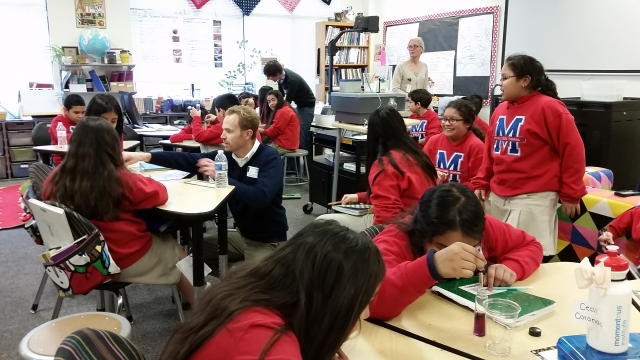June 1-2, 2015 -- at Tomas Rivera Elementary in Denton. This is a local elementary school with >90% Hispanic student population. We participated in their annual "Kids Inquiry Conference" by giving demonstrations on topics related to interactions of electromagnetism and matter as well as acid/base chemistry. The students (grades 1-5). The event also included presentations made by students to one another and their teachers, although our presentations were given separately and within the lunch hall of the school. We had a great time and got many excellent questions from the students. A teacher of one of the classes was kind to send us the photos of her students as they progressed through some of the demonstration stations. Captions are included with the photos below.


Left: Flyer for the Kids Inquiry Conference. Right: Justin Youngblood demonstrates
the circular birefringence of corn syrup among various refraction/diffraction demonstrations;
Antony Bazan seen at left waiting for a new student to see his luminescence demonstrations.
 Ivan Orozco showed the conductivity of various liquids (including pickle juice in
this photo) and materials, as well as the electrocatalytic separation of water into
hydrogen and oxygen.
Ivan Orozco showed the conductivity of various liquids (including pickle juice in
this photo) and materials, as well as the electrocatalytic separation of water into
hydrogen and oxygen.
 Antony Bazan shows the luminescence of inorganic and organic samples (phosphorescent
minerals, a peropyrene sample synthesized in our lab, pickle juice). Some students
take advantage of the opportunity to snag a portion of their alloted 15 minutes of
fame.
Antony Bazan shows the luminescence of inorganic and organic samples (phosphorescent
minerals, a peropyrene sample synthesized in our lab, pickle juice). Some students
take advantage of the opportunity to snag a portion of their alloted 15 minutes of
fame.
January 16, 2015 -- the Momentous School (part of the Momentous Institute). We visited this school in south Dallas with a student population that is >90% Hispanic and primarily composed of students from lower-income families.
In the pictures below, students are observing the color changes in an aqueous extract of red cabbage, which is purple in neutral solution, turns green and then yellow in alkaline solution, and turns red-orange in acidic solution. Also shown is the electrochemical splitting of water into hydrogen and oxygen. Additional demonstrations included fluorescence of organic compounds (carrot and cucumber extracts, and peropyrene), the diffraction of white light as well as lasers, and the circular birefringence (optical rotation of plane polarized light) of fructose (corn syrup).

Justin Youngblood (center-left), advises a pair of students on the addition of vinegar to red cabbage extract. Collin Perry (back center-left) helps another groups as class teacher Ms. Tracy Carnes observes (back center-right).

Collin Perry (center-left) demonstrates the chemical conversion of water into hydrogen and oxygen gases using a 12-volt battery, graphite electrodes (pencils), and a salt water electrolyte.

Students hold up their vials of red cabbage extract in a colorimetric arrangement from most acidic (at far left) to most alkaline (far right).